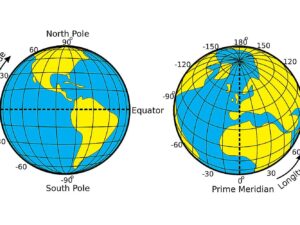What is the Standard Meridian of India?
-by Abhrajita Mondal
–Reading Time – 8 min Approx
A meridian is an imaginary, co-ordinate line that connects the North pole and the South pole. It indicates Longitude. Standard meridian is the longitude which is used to calculate and determine the time of a country. Moreover, it should be the same for the entire country. Different states cannot have different time zones. Did you ever wonder what is the standard meridian of India? Well, here is your answer – the standard meridian of India is located at 82.5 degrees East or 82°30′ east of the Greenwich Meridian. The longitude was selected as the meridian to create the Indian Standard Time (IST) back in the year 1905. It passes through the centre of the country.
Different states cannot have different time zones. Did you ever wonder what is the standard meridian of India? Well, here is your answer – the standard meridian of India is located at 82.5 degrees East or 82°30′ east of the Greenwich Meridian. The longitude was selected as the meridian to create the Indian Standard Time (IST) back in the year 1905. It passes through the centre of the country.
A Guide to what is the Standard Meridian of India:
The standard meridian of India passes through Mirzapur in Uttar Pradesh. In total there are 360 line of longitudinal. The standard meridian which has longitude 82°30′, passing through the city of Mirzapur in Uttar Pradesh, is considered to calculate the standard time for the whole country.
Now, why do we need a standard time?
When, a country passes through more than one time zone, there are more standard times applied throughout the country. India is a vast country through which several medians pass. The local times differ from one place to another throughout the country. It is important to adopt one central meridian.
There seems to be some ambiguity regarding whether the standard meridian of India passes through Allahabad or Mirzapur. You might have known that Allahabad is mentioned at certain places, instead of Mirzapur. In reality, this is because Mirzapur is a city near Allahabad. Thus, in many places, Allahabad has been mentioned instead of Mirzapur.
When you asked the question what is the Standard Meridian of India, these are the points that come to your mind.
Reason Why Mirzapur is taken as the Indian Standard Time Meridian in India:
There are a few more facts that you need to know. The longitudinal extent of India is 30 degrees. The whole thing is science and geography. You should know about it in detail just for your own knowledge.
It does not need to be repeated that the sun rises in the East and sets in the West. The sun requires about four minutes moving across one longitude. Thus, the eastern corner of India will be about two hours ahead of the westernmost part. This difference in local time can lead to a massive confusion. There would be confusion in rail timings and flight timings as well. To avoid this massive confusion, a longitude that lies in between 68ᵒ7’ East and 97ᵒ25’ (the longitudinal extents of India) East is chosen as the Standard Meridian of India to follow a common time throughout the country. Thus, the meridian at 82°30′ East which passes through the centre of India, is taken as the standard meridian of the country. It is followed by the entire country today. You can visit the city and check out the clock tower depicting the reference longitude of Indian Standard Time.
 More about Meridians of the Earth:
More about Meridians of the Earth:
A geographic meridian is half of the great circle that is imagined to run vertically over the Earth’s surface. It is quite commonly called a coordinate line. Each meridian is perpendicular to the lines of latitude. Everybody knows, that the best means to measure time is by the movement of the Earth, along with the moon and planets. Let us explain this with an example. When the sun is on the prime meridian of Greenwich, all the places lying on it have a mid-day. As the Earth rotates from the west to the east, those places located to the east of Greenwich are ahead of Greenwich Time and those to the West are behind it.
The local timings of places which are on different meridians will be different. For example, the local times between Dwarka in Gujarat and Dibrugarh in Assam are bound to differ by 1 hour and 45 minutes. Therefore, it shows why it is necessary to adopt a standard mean time. That is the reason why Indian Standard Time is so important.
Indian Standard Time is five and a half hours ahead of the Coordinated Universal Time, also known as known as the Greenwich Mean Time. The Indian Standard Time zone is a half-hour time zone. Its local timings differ by 30 minutes. Countries like India and Sri Lanka use this timing round the year.
If you are an avid traveller, you will have an idea how it works. It is quite fun to convert to different time zones. That is the primary reason why a person gets a jet lag. Flying in and out of various time zones takes its toll on the health of most individuals and it is never easy to accustom yourself to the new time zone. This is an amazing bit of information. If you are a student of geography, you will be well-acquainted with this fact. This article thus aims to increase your knowledge about how the time zones work, and what the Indian Standard time is. Hopefully, we were able to enlighten you.
-by Abhrajita Mondal


